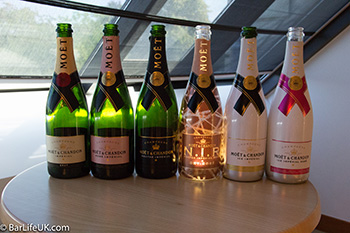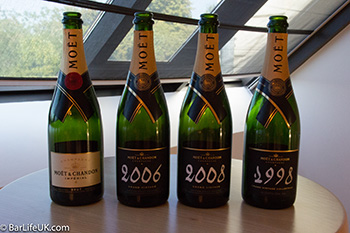Recently BarLifeUK went on a trip to Champagne with a bunch of bartenders to learn more about the world’s favourite celebratory tipple.
You can find out what happened on the trip as a whole here but during one particular tasting with Moet & Chandon Chef de Cave, Benoit Gouez we learnt so much we thought we would take our scribbled notes and get them typed up.
They are not in a particular order other than how we wrote them down, however if you are not as experienced in champagne as a category we hope you will find them useful.
There were actually two tasting a non-vintage and vintage. We’ll start with:
Non-Vintage
Sugar
Each style of champagne has it’s own rules as to the amount of residual sugar (per litre) to fall into that category. Some of the styles below will be more familiar than others, we haven’t covered every style but the main ones are here:
- Extra Brut – equal to or less than 6 grams
- Brut – equal to or less than 15 grams (by law 12 grams + or – 3 grams but the 15 gram rule is the general interpretation)
- Sec (dry) – between 20 – 30 grams
- Demi-Sec (half sweet) – between 35 – 50 grams
- Doux (sweet) – over 50 grams
The sugar itself has to be one of three different types of sugar.
- Beetroot sugar
- Cane sugar
- Grape sugar (from Italy & Spain)
Moet & Chandon use Beetroot sugar as it is the local option.
Grapes
Champagne is made with 3 grape varieties (with the exception of Blanc de blanc and Blanc de noir), all of which must be grown within the Champagne region of France. Whilst the percentages of grapes in each bottle is different the grapes themselves all bring distinctive nuances to the finished product.
- Pinot Noir (38% of all vines in Champagne) – Intense fresh red fruit and depth
- Chardonnay (29% of all vines in Champagne) – Green, floral, citrus, exotic fruits and freshness on palate
- Pinot Meunier (33% of all vines in Champagne) – White fresh fruit and mid palate
Maturing
The maturing length is a minimum period of time. A lot of the major champagne houses mature for longer, Moet & Chandon for example usually double the minimum maturing period.
- Non-vintage champagne – 15 months
- Vintage champagne – 3 years
Yeast
Champagne yeast is a specific variety of yeast that is used due to its ability to produce more bubbles than usual wine yeast. There are many different types of champagne yeast however the three most common are.
- Pasteur Champagne
- Epernay
- Premier Curvee (or Prise de Mousse)
Different yeasts are used for the first and second fermentation due to the different conditions – temperature, pressure etc
Vintage
Vintage champagne is not made every year, however there are no rules as to which years will be decided as a ‘vintage year’, each champagne house decides which year will be a vintage for them. The first vintage was officially made in 1822, the consensus of opinion is that vintages were made before this date however there is no proof.
There are rules for the production of vintage champagne:
- All wines must be from the same year
- Aged a minimum of 3 years
- Exactly the same production method as normal champagne
- Maximum of 80% of production for any champagne house can be vintage
Vintage champagne is just 10% of all champagne production (vintage rosé is only 1%). In their entire history Moet & Chandon have made a total of 72 vintages however in recent times the number of ‘vintage years’ has increased due to our old friend Global Warming.
We tried several amazing vintage champagnes and my number one tip is if you see a bottle of Moet & Chandon 1998 buy it, then buy us one, then drink them both. It is phenomenal.


